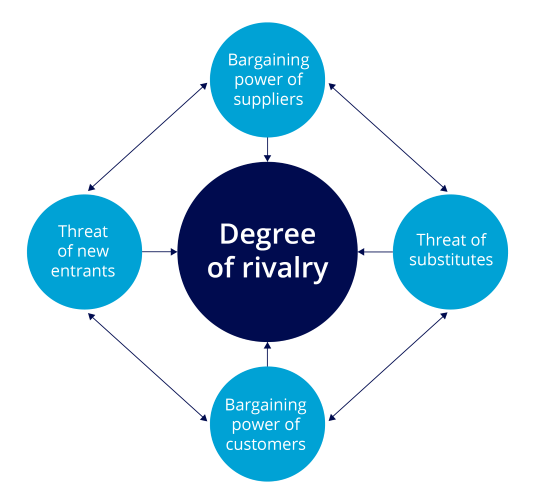
Porter’s Five Forces is a framework that we often use to assess the competitive landscape in which our clients currently operate or intend to enter. This framework was designed by Michael Porter of Harvard University, who felt that a more traditional SWOT analysis was not always sufficient in assessing the competitive landscape, and how attractive (or otherwise) it might be.
Why is competitive landscape analysis important?
One of the key applications for this framework is when one of our clients is interested in entering a new market. It is essential to conduct some ‘due diligence’ to help better understand the market and develop a strategy. Using the Five Forces framework can help an organization to assess whether the market is attractive to enter, and where the key challenges might lie.
This framework is also a useful complement to a brand health assessment. It provides valuable context to the market landscape, when assessing awareness and perceptions of different brands in the market.
What is the Five Forces framework?
Porter identified five forces that are present – to varying extents – in all operating environments. Where all of the forces are very strong, this indicates a competitive landscape that is highly challenging – and perhaps unattractive for a new business to enter. Where all are very weak, this represents significant opportunity for a new business.
In most cases, the picture is more nuanced – some forces in a market might be strong, while others are relatively weak. In these instances, we can use the Five Forces framework to understand particular areas of challenge and opportunity, to help our clients develop strategies for market entry or penetration.

What are the ‘Five Forces’?
There are two vertical forces: bargaining power of suppliers, and bargaining power of buyers…
↓ Bargaining power of suppliers
This force indicates the level of power suppliers hold over businesses in the market. Where a supplier holds more power, businesses rely more heavily on them.
An example of suppliers holding strong bargaining power might be due to their holding a monopolistic position in the market. In this instance, they can charge higher prices, which might threaten the stability of any businesses using them as a supplier.
Other considerations to assess the bargaining power of suppliers might be:
- Do suppliers hold patents, or use special, proprietary technology?
- Are suppliers vertically integrated with any of your competitors?
- How many suppliers does your business have; how large are they?
↑ Bargaining power of buyers
This force indicates the power that buyers, or customers, hold over businesses. Some considerations to help assess the bargaining power of buyers might be:
- How price-sensitive is the market?
- How easy is it for customers to switch to new suppliers?
- How many customers does your business have; how large are they?
There are two horizontal forces: threat of new entrants, and threat of substitutes…
→ Threat of new entrants
This force looks at how easy or difficult it is for new competitors to enter the market. If there are high barriers to entry, this force is weaker. If it is easy for new competitors to enter the market, this force becomes stronger. Some key questions to consider might include:
- How strong is your business’ existing reputation in this space; how important is this to customers, and how difficult would it be for a new entrant to build a comparable reputation?
- How difficult and/or expensive is it for a new business to enter this market?
- Are there any unique skills or technologies that a business would require to be successful in this market?
- How cost-sensitive are customers; is it likely that a new competitor could enter the market with lower prices?
← Threat of substitutes
This force relates to the availability of an alternative product or service. If a business is a producer of orange juice, a new entrant would be another company that makes orange juice – whereas a substitute might be a company that makes apple juice. If more customers are switching to apple juice instead of orange juice, this would be a significant competitive force. Some additional considerations:
- How easy or difficult is it for customers to switch to an alternative product or service?
- How cost-sensitive are customers; is it likely that a substitute might be available at lower prices?
- Is it a possibility that customers might choose to undertake the service you offer, internally?
Finally, in the middle of the framework, we look at the current level of competitive rivalry. This is depicted in the middle of the framework, because it is based upon activity within the competitive set – rather than being imposed from other directions.
• Competitive rivalry
There are several elements to consider here, while bearing in mind that all competitors will be exposed to the four forces we have already outlined:
- How many competitors are there?
- How does the market share split between competitors?
- How loyal are customers?
- How big are the profit margins?
What other frameworks might be used during competitive landscape analysis?
- SWOT analysis offers a broader assessment of the Strengths, Weaknesses, Opportunities and Threats that might impact a business. Strengths and Weaknesses are internal factors, while Opportunities and Threats are external. Many of the topics we have discussed within the Five Forces might fall into Opportunities or Threats – for example, a high level of competitive rivalry would be considered a threat.
- PESTLE analysis can help us to assess the more macro factors (Political, Economic, Social, Technological, Legal, Environmental) that might impact the ease of operating in a market and the resultant business strategy.
- It is also important to remember that competitive markets do evolve over time. Therefore, it is wise to re-visit the Five Forces framework over time, to ensure that the business strategy is as strong as possible.
Readers of this article also viewed:
What to Consider When Evaluating Market Opportunities How Market Research Can Help Guide Your Market Entry Strategy Using the Push-Pull Model to Successfully Bring New Products to Market Assessing Market Attractiveness with the Directional Policy Matrix PESTLE Analysis: Understanding Market Influences for Better Decision-Making SWOT Analysis: Identifying Strengths, Weaknesses, Opportunities & Threats
To discuss how our tailored insights programs can help solve your specific business challenges, get in touch and one of the team will be happy to help.


